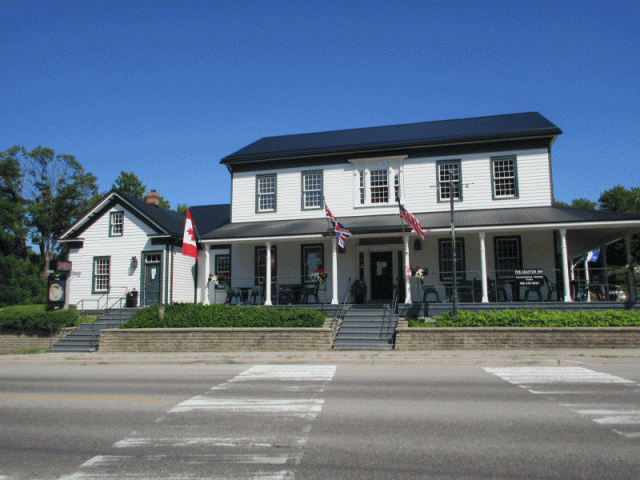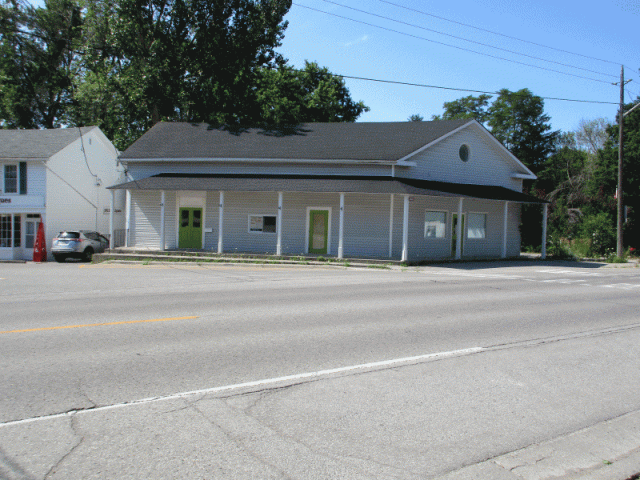
“Look up…waaaaay up!” are words likely etched in the memories of many generations of Canadians, were made famous by one of Grafton’s most notable citizens Bob Homme. Read his story later in this post. Grafton, located 12 Kms east of Cobourg on County Road #2 north of Lake Ontario is a small village very big on history. This village was originally known as Grover’s Tavern, for a short time was called Haldimand Post Office and the name was officially changed to Grafton after the Inn Keeper John Grover’s birthplace in Grafton Massachusetts. By the late 1870’s Grafton was home to a doctor, several taverns and inns, a cheese factory, a blacksmith shop and a Lake Ontario harbor.
In the 1850’s the Grand Trunk Railway built their railroad 1.7 km. south of the village. This was done by many railroad builders to acquire large parcels of land at cheaper costs for their stations, sidings and shops. In the early 20th century, the Canada Canning Company took advantage of lower cost land and the Canadian Northern Railway now serving the area. In 1904, they constructed many factory buildings, bunkhouses, workers cabins and a massive factory chimney which was a landmark for miles away. Prosperity and many jobs were provided to local residents up to the 1950’s. By 1998, the factory and most of its buildings were demolished leaving very little trace of its past glory giving the name Grafton Ghost Town to the area. In recent years this area and towards Lake Ontario is being re-developed into housing. This new community is still part of Grafton but will forever be separated by railway tracks.
The impressive Alnwick/Haldimand Township Hall located at 10836 County Road #2, was constructed in 1859 and became in important centre for business meetings and formal balls. On the opening of the hall the Grafton Brass Band, the Grafton Serenaders and other amateur performers gave a concert in the hall. Council met here for the first time in 1860. The attractive Township Hall Annex to the east was built as a simple Neo-Classical home and is now owned by the township and used as office space. Built in 1860 by Scottish master carpenter John Aird, the original plank and clapboard building is now covered by aluminum siding.

Eliakim Barnum was in his early 20’s when he emigrated from the U.S. in 1807. He settled in Haldimand Township at the village of Grafton. By 1819 he had acquired over 364 hectares (900 acres) of land, a thriving milling business, a tavern and a distillery. Barnum was a Justice of the Peace, a founder of St. George’s Anglican Church in Grafton and a Lieutenant – Colonel of the Northumberland 3rd Battalion (militia) and helped start the first school in the township in the 1820’s.
In 1819 he built the home that is today one of Ontario’s finest Neo-Classical structures. The site was originally built upon in 1811 by Barnum’s brother-in-law James Norris. The Norris home was accidentally destroyed by fire during the War of 1812 by British soldiers billeting there. The current house located at 10568, County Road #2 in Grafton remained in the ownership of the Barnum Family until 1917 when it was sold to a local resident, Harry Prentice. The Architectural Society of Ontario (ACO) acquired the house in 1940 and refurbished it and opened it as the provinces first period house museum. In 1982, ownership was transferred to the Ontario Heritage Trust. The museum appears to be closed at this time.

The second most noticeable building on the main street of Grafton is the historical Grafton Village Inn located at 10830 County Road #2. This attractive building was built in 1833 to replace a log structure. The original building on this site was known as Grover’s Tavern, Grafton’s namesake. In 1832 Grover sold the hotel to Edward Pepper and it was now known as Pepper’s Tavern and it was here that the village name Grafton was adopted. The tavern sometime later became The Grafton Village Inn.
In the early 1990’s this beautiful Neo-classical building was restored to what it would have looked like to the early travellers arriving from Kingston, York (Toronto) or the bustling Grafton harbour which was located some distance south of the village. Today this building is well known as a restaurant and a B & B establishment.

Robert ‘Bob’ Homme, better known as The Friendly Giant was born in Stoughton, Wisconsin in 1919 and died in Grafton, Ontario 2000. Becoming a citizen of Canada in the early 1900’s, he held dual U.S. – Canada citizenships. Mr. Homme was best known as the host of the popular children’s television show “The Friendly Giant” which aired from 1958 – 1985 on CBC. With his sidekicks ‘Rusty’ the rooster and ‘Jerome’ the giraffe they had produced more than 3,000 episodes of the show. By 1984, government cut-backs in CBC’s budget ended the program. The replacement show, Fred Penner’s Place has been referred to by some as “the Giant Killer”.
For many years Mr. Homme resided on his farm just north of Grafton and was often seen playing his clarinet at the Grafton Village Inn. Awarded the Order of Canada in 1998 and being too ill to travel to Rideau Hall in Ottawa, the Governor General made a rare exception in the rules and travelled to Grafton and held the ceremony at the Grafton Village Inn. A great honour for Robert, the Inn and for Grafton. After the ceremony Mr. Holmes told the crowd, “I’ll always remember this day as a perfect cap of thirty-odd years of just having a wonderful time simply being friendly”. Mr. Homme died in May, 2000. In 2005, The Friendly Giant was honoured as a ‘Masterwork’ by the Audio-Visual Preservation Trust of Canada.

The Lawless Store at 10831 County Road #2, was constructed around 1835 by James Lawless with lumber supplied by William Taylor’s mill in nearby Eddystone. The walls were constructed with one inch planks nailed on top of each other and staggered for extra strength. James, his wife Harriet and son Thomas arrived in Grafton in 1834. In 1848, James and two sons died suddenly leaving his widow and four sons and a daughter. From 1848 – 1860 Harriet struggled but lost control of the business and sometime later the store was repurchased by their descendants. After four generations of the Lawless family, their store was closed in 1964. The store has since gone through several uses, a tea shop, an antique shop, a restaurant, meat market and most recently by local entertainer Aengus Finnan under the name of The Lawless Art Gallery.
When in Grafton, be sure to stroll south down the Old Danforth Road, Grafton’s original main street. Note the 1812 Heritage Building (105); the Lawless House (126); The Grover House (136); Reuban Lawless House (154); The Old Foundry House (160) and The Old Presbyterian Sunday School (135).
Regards, Ranger

Where was the Grafton Port or Harbour located? What road?
LikeLike
Walter, Thanks for the comment. The Grafton Port/Harbor was located south of Northumberland County Road 2, from Station Road or from Brimely Road, south of the railway tracks. Ranger.
LikeLike
You won’t believe how I got to your site. Started out by looking at Christopher Plumber’s history… “John Bethune (1751 – September 23, 1815) founded the first Presbyterian Church in Montreal and was the patriarch of a notable Canadian family prominently connected with the fur trade, politics, medicine, law and the church. He was the great-great-grandfather of Norman Bethune, the Canadian physician and medical innovator, and the great-great-great-grandfather of Canadian actor Christopher Plummer.” A family friend who passed last year had a package of letters from Dr. Norman Bethune written to her grandparents…. to… “Christine Bethune (1787–1865), of Cobourg. Her first husband was John Low Farrand of Cornwall, Ontario. Secondly, she married Robert Henry, son of explorer Alexander Henry. He was wintering partner of the North West Company and director of the Commercial Bank of the Midland District at Cobourg.”
I then clicked on Cobourg, ON, where a mention of Burnham House and Grafton was found. I spent most of my “Kid” summers visiting Forrie and Percy Prentice’s farm near Grafton. It’s my understanding that Percy was born in Burnham House. My 2nd cousin is David Prentice who was an auto mechanic at (I think) Prentice’s garage in Cobourg. One of his sisters (Maggie???) was the Post Mistress for Grafton at a time when women seldom held such positions.
What a wonderful journey, thank you for your contribution to a fascinating history. God Bless the Internet!
After 18 years living in Port Moody, BC, I still miss Ontari -ar-ario!
LikeLike
Sara, thanks for the amazing comment. So much history! Very happy you found our site. The letters from Dr. Norman Bethune would certainly make interesting reading. I am familiar with the Prentice name as this business is still operating in this area. We are all grateful for the Internet. You might not miss Ontari-ar-ario today…cold, windy and snowy! Thanks again for the history lesson.
Ranger.
LikeLike
I was raised IN the Kapuskasing Inn where my father was assistant manager (1949s) so I think I could handle the weather but my husband refuses to shovel snow now!
thanks for the lovely reply, Sara
On Fri, Jan 28, 2022 at 5:29 AM 2 Old Guys Walking wrote:
> 2oldguyswalking commented: “Sara, thanks for the amazing comment. So much > history! Very happy you found our site. The letters from Dr. Norman Bethune > would certainly make interesting reading. I am familiar with the Prentice > name as this business is still operating in this area. ” >
LikeLike
Lynne, great comment, I stand corrected, if you could handle Kapuskasing weather, you know what Ontario is like.
It is expected our weather will warm up considerably next week, sure hope so!
Regards, Ranger.
LikeLike